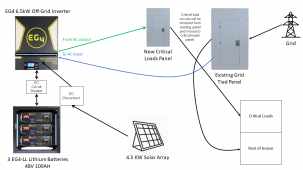Boogarweed
New Member
- Joined
- Jan 17, 2022
- Messages
- 3
I am a total solar newbie. I have watched a lot of Youtube “how tos” on solar and I THINK I know what I want to do but would really like a gut check from those of you who know what you’re doing. Thanks in advance for the help! I purchased the following equipment:
1ea EG4 6.5kW Off-Grid Inverter
3ea EG4-LL Lithium Batteries - 48V 100AH
1ea DC Disconnect
1ea DC Circuit Breaker
10ea 455 watt solar panels
Various cables
I would like to move my critical loads from my existing panel to a new critical loads panel. Then use the EG4 inverter to power the critical loads panel. I would like to use solar first, then battery and then grid power. I have 2 questions; First, is this doable? Then, if so, is this what I should do since my goal is to cut grid usage as much as possible and have a backup in case of grid down for critical loads. I will upload a drawing of what I am planning.
1ea EG4 6.5kW Off-Grid Inverter
3ea EG4-LL Lithium Batteries - 48V 100AH
1ea DC Disconnect
1ea DC Circuit Breaker
10ea 455 watt solar panels
Various cables
I would like to move my critical loads from my existing panel to a new critical loads panel. Then use the EG4 inverter to power the critical loads panel. I would like to use solar first, then battery and then grid power. I have 2 questions; First, is this doable? Then, if so, is this what I should do since my goal is to cut grid usage as much as possible and have a backup in case of grid down for critical loads. I will upload a drawing of what I am planning.



